By Katy Green and Jean English
In order to provide more in-depth and integrated coverage of meetings of the Maine Board of Pesticides Control (BPC), The MOF&G is making this annual report covering all 2015 meetings, rather than the quarterly reports we previously ran. Complete documents relating to BPC meetings are posted at https://www.maine.gov/dacf/php/pesticides/meetings.shtml. MOFGA posts time-sensitive action alerts related to the BPC throughout the year at https://www.mofga.org/Programs/PublicPolicyInitiatives/MaineBoardofPesticidesControl/tabid/3073/Default.aspx.
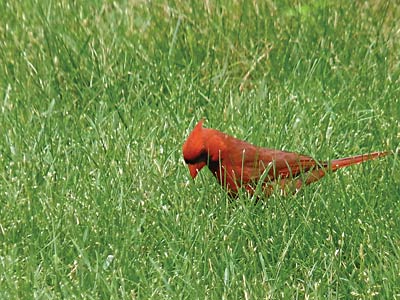 |
| Lawns should be safe for all of us. An incident involving a lawn in Falmouth brought the issue of lawn-applied pesticides to the attention of the Maine Board of Pesticides Control in 2015. English photo |
The BPC, Maine’s lead agency for pesticide oversight, is attached to the Maine Department of Agriculture, Conservation and Forestry. A seven-member public board makes policy decisions. The 2016 BPC budget was projected to have $2,135,152 in revenues, with pesticide registrations as the main source, and $2,024,906 in expenditures, primarily for wages, salaries and benefits.
Katy Green, MOFGA’s organic transitions coordinator, attends all BPC meetings to represent MOFGA’s views. This summary is taken from BPC minutes and Green’s notes.
Pesticide Applications to Lawns – Broad Repercussions
Perhaps the 2015 BPC event with the greatest repercussions involved a letter from a landscaper who was poisoned by pesticides.
Landscapers Justin Nichols and Gail Jones were working at a client’s property in Falmouth for about 35 minutes when both became ill. They then saw a sign indicating the lawn had been sprayed by TruGreen just before they arrived. Nichols called three different numbers four times, was transferred multiple times, and still got no information about what products had been applied. The couple eventually learned that the herbicides dithiopyr, MCPP-p, dicamba and 2,4-D, the insecticide imidacloprid and a fertilizer had been applied. The products used were different from those the landscapers were originally told.
Maine pesticide regulations require only a phone number on posted signs, and signs must be placed in advance of applications and remain for 48 hours. Nichols subsequently wrote to the BPC with recommendations for better signage, including placing more and larger signs on properties, noting pesticides used and their EPA registration numbers, and giving a local number to access information rapidly.
Regarding this issue, Paul Schlein, a member of MOFGA’s Public Policy Committee, also submitted suggestions to the BPC (https://www.maine.gov/dacf/php/pesticides/documents2/bd_mtgs/nov15/paul-schlein_letter-to-bpc_10-16-15_final-rev.pdf), as did MOFGA (https://www.mofga.org/Portals/2/Public%20Policy/BPC%20Letter%20Endorse%20Schlein%20Letter.PDF), Friends of Casco Bay, the Natural Resources Council of Maine (NRCM), the Conservation Law Foundation, Jody Spear and Ann Mullen. Robert J. Tardy of Somerset Associates in Newport also submitted a letter on this issue.
Schlein advocated that the BPC bolster sustainable and low-risk programs and practices, including the YardScaping program (https://www.maine.gov/dacf/php/pesticides/public/yardscaping.shtml) and the BPC GotPests? website (https://www.maine.gov/dacf/php/gotpests/index.html); create a position that focuses solely on public education and outreach; fund and launch a major statewide media campaign to promote sustainable lawncare and landscaping; enhance BPC training and licensing modules, or create new ones, focusing on sustainable lawncare and landscaping practices and alternatives to pesticide use; and convene a meeting with other state agencies and private interest groups to review the status and implementation of Maine’s policy to minimize reliance on pesticides.
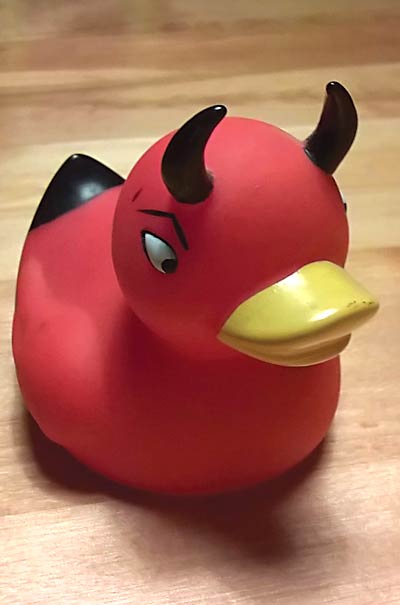 |
| Effective, award-winning television ads featuring rubber duckies as a way to teach the public about the risks to water quality from polluted runoff were pulled from the Maine Department of Environmental Protection website at the direction of then-Deputy Commissioner Aho. Photo courtesy of Paul Schlein |
Schlein has also suggested, repeatedly, that the BPC promote an award-winning “ducky ad.” The Think Blue Maine Devil Ducks ad is posted at https://www.youtube.com/watch?v=wJCHZLAw18M.
In its 2013 report “Troubled Waters – Damage to Maine’s Lake Protection Program Under the LePage Administration,” the NRCM wrote, “DEP is part of a coalition known as ThinkBlue that has produced two award-winning television ads featuring rubber duckies as a way to teach the public about the risks to water quality from polluted runoff. However, in April 2011 when lawn care companies complained about one of the ads to Governor LePage, the ads quickly disappeared from DEP’s website at the direction of then-Deputy Commissioner Aho.
“The 2011 ‘Devil Ducks’ ad shows yellow duckies turning red to symbolize the risk to water quality from runoff containing fertilizer and bug and weed killers. The ad was developed based on extensive focus group research. DEP paid 56 percent of production and media costs for the campaign. A survey conducted after the ads aired demonstrated that they had been successful in raising awareness about the [importance] of reducing pollution runoff.
“…On March 9, 2011, before the ad began airing, DEP Spokesperson and Director of Education and Outreach sent an email to Commissioner Darryl Brown and Deputy Commissioner Patricia Aho,” calling the ad “a vulgar use of our department’s time and funds …
“… After the ad had begun airing,” the NRCM report continues, “Governor LePage received an email written by Chris Turmelle of Atlantic Pest Solutions” calling the ad “anti-lawncare.”
Samantha DePoy-Warren, then communications director at the DEP, emailed staff involved in the advertising campaign, saying: “Obviously, an anti-lawn care ad as many see this does not sit well with those industries, who do their part to present eco-friendly options to counsumers (sic) and who are important creators of jobs in Maine especially at this time of year. For starters, I’d like this ad pulled off the Maine.gov media library page to protect the state and the department. Secondly, I need ASAP a one-page overview that explains the details of the ad creation and buy as well as the thought process behind the ad and the message it was trying to send. I’d ideally like this well before the end of the day, so I can forward it onto the Governor’s Office, which has requested this overview.”
The ads were removed from the DEP website, “eliminating the continued education value that the ads could be providing,” says NRCM, adding, “Companies that sell fertilizer and pest control chemicals prevailed in stifling further utilization of the ad by DEP.”
The letter that MOFGA sent to the BPC regarding synthetic chemicals applied to lawns urged the BPC to reduce reliance on pesticides, to increase education efforts about alternatives to pesticides and to track and report on pesticide sales in Maine. It stated, “MOFGA is particularly concerned about the approximately 700 percent increase in pesticides used in and around homes and in public areas in Maine in the past 20 years.” (https://www.mofga.org/Programs/PublicPolicyInitiatives/MaineBoardofPesticidesControl/tabid/3073/Default.aspx)
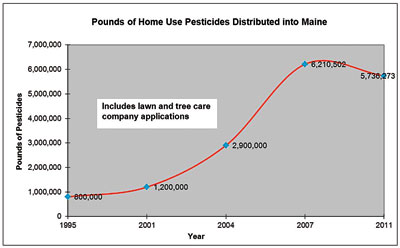 |
| The increase in amounts of pesticides distributed in Maine has alarmed MOFGA and several other groups and individuals in the state. Source: https://maine.gov/dacf/php/pesticides/yardscaping/lawn/index.htm |
In response, the BPC staff wrote to all companies licensed to apply pesticides that require posted notice. The board said it feels strongly that the telephone number listed on the notification sign should always be answered by someone who can quickly answer individuals who call with concerns about a pesticide application, especially the product name, EPA registration number and method and rate of application. The BPC also asked applicators to follow requirements about posting in a manner and at locations designed to reasonably assure that people entering treated areas will see the notice.
The board also discussed ways to counter the increased pesticide use by homeowners, and it heard from other state entities that it partially funds about their promotion of IPM (integrated pest management) among homeowners. The board directed the staff to create a list of actionable ideas for homeowner education. At its January 2016 meeting, the BPC discussed actionable items and agreed to move forward on three immediately: to re-energize the IPM network in the state, consolidate lawncare recommendations on its website and begin to send more content to the media regarding IPM use by homeowners. The board repeatedly declined to gather additional data regarding pesticide use in the state, which MOFGA argued may make it difficult to determine if the increased outreach efforts actually correspond with reduced pesticide use.
In a related matter, the BPC heard that a homeowner allegedly removed pesticide application notification signs as soon as a lawn care company left the property. Maine law requires that signs remain place for at least two days after completion of the application. Board members said that other, similar incidents have occurred.
Pesticide Applications and Public Notification for Public Parks and Playgrounds
Board director Henry Jennings said that LD 1098, introduced during the last legislative session, attempted to apply school rules to public parks and playgrounds. It did not pass, but the Legislature’s Joint Standing Committee on Agriculture, Conservation and Forestry asked the BPC to determine whether standards for pesticide application and public notification for public parks and playgrounds should be consistent with those for school buildings and school grounds.
Consistency is not practical, said Jennings, because with schools, the population that will be present is generally known, and if a high-risk application were to be made while school was in session, parents and staff would be notified. This is not true for parks. For low-risk applications, signs are already required, which is consistent with signs used on school grounds. Regarding standards for application, schools, unlike parks and playgrounds, have someone present who can pay attention, use IPM, maintain a log and apply pesticides when circumstances dictate. State law already requires that pesticide applications at parks be conducted by a commercial applicator with the correct license.
Katy Green asked the board if its current pesticide notification registry could be expanded to allow registrants to be notified when public parks they frequent are treated. The board did not believe that this was a workable solution and suggested that it would be similar to opening Pandora’s box.
The staff drafted a letter to the legislative committee explaining these difficulties.
Schools
Heidi Nelson, pesticide inspector for Eastern Maine, has visited all the schools in her district. All have conscientious IPM coordinators, she reported. A lack of funding limits pesticide applications.
Jennings said southern Maine is more of a challenge because of the number of schools. Field personnel have been told to press schools to comply with pesticide regulations. The message has gotten out that licensed applicators and not school personnel need to do any pesticide applications. The notification system in Chapter 27, he added, has discouraged high-risk applications, as has the board’s threat to take compliance action against schools. (Chapter 27 requires, among other things, that schools notify staff and parents or guardians before most pesticides are applied.)
Pesticide Applications on Outdoor Property Open to Use by the Public
Regarding pesticide applications to private lands open to use by the public, such as land trusts, recreational areas, trails and parks trying to control invasive plants and/or poison ivy, the board previously said that if the treated area is closed and signage keeps people away, then this is not considered “property open to use by the public,” so no commercial applicator license is required. The staff sought guidance from the board on whether the entire property or just the treated area must be closed.
The board believes this exemption is used most commonly by land trusts to treat for invasive plants and that they post and indicate the area (but not the entire “property”) that is temporarily closed to the public.
The BPC staff surveyed 80 land trusts and found that many are doing their own invasive species control, but few are hiring commercial applicators. Only two or three have licensed their own master applicators. Of the 51 land trusts that responded to the survey, 47 percent said they sprayed and 53 percent said they did not.
The board approved a policy statement saying that because pesticide applications to recreational areas, trails and parks pose minimal risks, the exemption from consideration as a “property open to use by the public” is appropriate when the public is excluded from treated areas for seven days. Pesticide applications under those circumstances will not require supervision by a licensed commercial applicator.
Guidelines for Forest Pesticide Applications
In April 2015 the Maine Department of Environmental Protection finalized a general permit for aerial application of pesticides to forestry sites and referenced BPC Best Management Practices. Additionally, at the Joint Standing Committee on Agriculture, Conservation and Forestry work session for LD 817, An Act Regarding Aerial Pesticide Spray Projects, discussion occurred about adding references to technological advances for aerial spraying. So at the June BPC meeting, the staff presented and the board approved a document called “Guidance for the Application of Pesticides In Forest Settings In Order to Minimize the Risk of Discharges to Surface Waters.” The board approved the document, with some edits, which lists some state and federal laws regarding pesticide applications; provides guidelines on choosing, handling and applying pesticides; on treating sensitive areas; managing drift; considering weather conditions and making aerial applications.
Application of Pesticides to Unoccupied Hotel Rooms and Apartments
The BPC adopted a policy that pesticide applications to lodging places or apartment buildings must be made under the direct supervision of a licensed commercial applicator unless the public is excluded from the entire building for a full seven days.
Letter to Health Care Facilities
After an hospital employee who was unlicensed and untrained in pesticide applications did apply pesticides to patients’ rooms at the Charles A. Dean Hospital in Greenville, the BPC staff sent a letter to Maine health care facilities alerting them that only properly licensed applicators may use pesticides to control, repel or mitigate insects, rodents, weeds or other pests in and around health care facilities. Even products sold over-the-counter and labeled as “all natural,” “organic” or “nontoxic” require a license when applied to property open to the public.
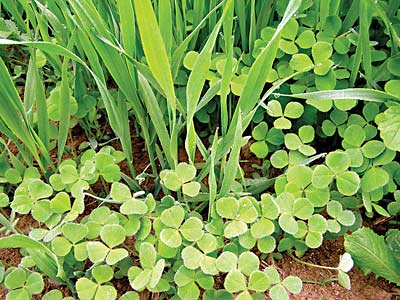 |
| Maine’s organic farmers are not hampered in their choices of cover crops, such as the oats and clover shown here. Conventional growers who use certain herbicides, however, face restrictions on crops that they can interplant or rotate with cash crops, even if the cover crop is not intended for food or feed. English photo |
EPA Labels vs. Cover Cropping
Board member John Jemison said many farmers plant cover crops on their corn fields during the growing season to enhance soils. If they wait until corn is off the field, cover crop growth is poor because the crop was planted so late. Jemison noted that USDA is encouraging multispecies cover crop mixes, and some growers qualify for cost share money. But if growers use an herbicide on the corn field that has a plant back restriction – a label restriction prohibiting planting certain crops on the site after that herbicide was used – they are breaking the law, even if the cover crop is not being grown for food or feed. So herbicide labels appear to prohibit most recommended cover crops, and Jemison is concerned that the government may be paying for growers to do something illegal.
LeBelle Hicks, BPC toxicologist, reviewed 32 herbicide labels for commodities grown in Maine. Twelve had specific language regarding cover crops: the others did not. Some had directions on doing bioassays before planting the cover crop to see if the plant grows well or not. One said not to count frozen ground time as part of the rotation restriction; another had a three-year restriction on planting cover crops; yet another had guidelines for rotation intervals and restrictions for planting a new crop depending on rain, irrigation, etc.
While some state universities and agriculture departments say that cover crops can be planted after any herbicide application if the crops are not used for food or feed and if growers will accept a reduced stand (because the cover crop may be sensitive to the herbicide), Jennings said those statements are not from EPA.
Hicks is trying to get the State FIFRA Issues Research and Evaluation Group’s Pesticides Operations and Management subcommittee to write an issue paper to send to the EPA to address this problem. (FIFRA is the Federal Insecticide, Fungicide, and Rodenticide Act.)
Jennings drafted a letter to the EPA and to the Maine Congressional delegation about this issue.
Pesticide Safety for Migrant Workers
The BPC approved a $3,500 grant to the Maine Migrant Health Program and Eastern Maine Development Corporation for a worker safety training program for the summer of 2015 – something the board has done since 1995. Elizabeth Charles of the Maine Migrant Health Program said that in 2014 the program hired one person who presented a standardized Worker Protection Standard curriculum, farmworker opportunity curricula, pesticide safety around families and children and heat stress prevention.
In January 2016 the BPC approved a $3,675 grant to the program. The slight increase in funding will help cover an increase in costs related to administering the program.
Water Quality Monitoring
Maine law directs the board to survey for pesticide residues in ground and surface water. Mary Tomlinson, pesticides registrar and water quality specialist, said that groundwater samples taken in March and April 2014 from 47 wells were tested for 96 pesticides. Thirty-two wells tested positive, and 23 analytes (chemical constituents) were detected for a total of 81 hits. Ten wells had very low concentrations, while one was tested again because the numbers were above the maximum contaminant level. Jemison agreed to try to help mitigate impacts on that well.
In 2015, testing of 50 wells detected seven pesticides in 43 wells with a total of 62 detects, all well below maximum contaminant levels and health advisory guidelines, according to Tomlinson.
Also related to water quality, the BPC convened an Environmental Risk Advisory Committee (ERAC) in 2014 to “examine whether current pesticide residues have the potential to affect the lobster industry in Maine directly or via impact on other marine organisms.” It submitted a report to the Legislature in January 2015 (https://www.maine.gov/dacf/php/pesticides/documents2/erac/2015%20ERAC%20Report%20to%20Legislature-final-1-15-with-appendices.pdf) that identified four priority compounds for analysis: pyrethrins, synthetic pyrethroids (including resmethrin), methoprene and fipronil.
The staff also sampled 20 marine sediment sites from Kittery to Cobscook Bay in conjunction with the lobster ERAC, including urban, suburban and rural sites deemed most likely to have detectable residues. The Montana Analytical Laboratory, which ran the more sensitive analysis for pyrethroids, detected bifenthrin (a synthetic pyrethroid) at 11 of the 20 sample sites and cypermethrin (another synthetic pyrethroid) at one site. Southwest Research Institute reported no detections. Neither methoprene nor resmethrin were detected. The BPC staff was surprised by detection of cypermethrin. The sample size was small, said the staff, but its preliminary conclusion was that pyrethroids are getting into the marine environment where they were expected. The report noted, however, that “nothing in the Environmental Protection Agency’s current pesticide registration documents suggests that an unreasonable risk to aquatic invertebrates exists.”
Storm water sampling took place again during the summer of 2015 at 20 sites from Kittery to Cobscook Bay. The BPC had not yet analyzed these data when we went to press.
The ERAC is continuing its work and will provide updated information to the Joint Standing Committee on Agriculture, Conservation and Forestry in January of 2017.
Managed Pollinator Protection Plans
The board reviewed the federal Managed Pollinator Protection Plans that the EPA is promoting to help reduce pesticide risks to pollinators. States were being encouraged to work on state-specific plans. Because pollinator protection relates to more than pesticides, the Maine Department of Agriculture, Conservation and Forestry drafted a plan (https://www.maine.gov/dacf/php/documents/MaineDACFPollinatorProtectionPlan_11-18-15.pdf) that focuses on managed hives and emphasizes education, improved communication and promotion of pollinator health Best Management Practices (BMPs).
Board member Curtis Bohlen noted that communication needs for pollinator protection and for other notification issues include an urban component, sensitive areas for aerial spraying, identifying key locations and figuring out with whom to talk. Jennings noted that a mapping program called DriftWatch (which the BPC did not have) can address beekeepers’ and organic farmers’ concerns. For example, beekeepers mark their location, the applicator marks a location, then an automatic notice is emailed.
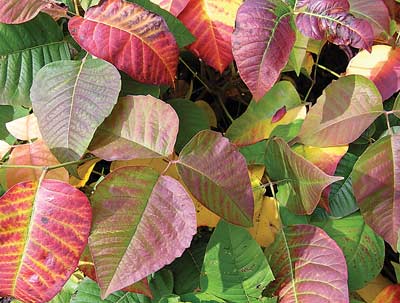 |
| The Maine Board of Pesticides Control sometimes grants variances to those who want to spray synthetic herbicides within 25 feet of bodies of water to control poison ivy and invasive species. English photo |
Registration Renewals and Variance Requests
The board approved a request from United Phosphorus, Inc., for a five-year renewal of its Special Local Need Registration for Asulox Herbicide to control bracken fern on lowbush blueberries. In 2010 the board approved such a registration for spot treatment of bracken fern during the non-bearing year only. Jemison expressed concern about the potential toxicity of this herbicide and lack of testing for residues in water.
The board also approved a request from the Maine Department of Agriculture, Conservation and Forestry Division of Animal and Plant Health to recertify a petition to EPA for an exemption to use HopGuard II (potassium salt of hop beta acids) to control varroa mites in managed bee colonies. State apiarist Tony Jadczak sought approval to continue use of this product, which had provided consistent control against varroa mites during the last three seasons and is an important alternative in resistance management and organic honey production. Jadczak said that in 2014 Maine had 909 beekeepers with approximately 10,000 hives. Approximately 83,000 hives were shipped in last year. More land is going into blueberry production, and the blueberry crop in 2014 was the largest on record.
The BPC voted that if a variance permit request from a railroad for pesticide applications meets certain criteria, the staff can approve the variance for two years; otherwise requests go to the board. This policy will be reviewed in two years.
Variance permits for applying pesticides within 25 feet of water were issued in 2015 to the following:
• Ryan Minzner of The Woodlands Club in Falmouth for its pest management program
• Vegetation Control Service, Inc., to spray wetlands at the transmission line at the Kibby Wind Power Project when no surface water is present and when no rain is predicted for the area for the 24-hour period following applications
• Maine Department of Transportation, Bureau of Maintenance & Operations, for weed control along state-maintained roads and other transportation facilities
• RWC, Inc., for vegetation control on railroad rights of-way
• Asplundh Tree Expert Co. Railroad Division for vegetation control on railroad rights of-way
• Dubois Contracting for broadcast application of herbicides along portions of the Ft. Kent levee along the St. John and Fish Rivers
• June Barden for control of poison ivy in Windham using broadcast pesticide applications within 25 feet of water, provided the applicator uses low-pressure equipment and directs the spray away from the water
• Ronald C. Lemin Jr. of RCL Services LLC in Bangor to treat Japanese knotweed within 25 feet of a streambed on the property of Reggie Pratt in Minot
• Jeffrey M. Taylor of Vegetation Control Service, Inc., of Athol, Mass., to treat within 25 feet of water various invasive plants along public roadside rights-of-way in Falmouth
• Vegetation Control Service, Inc., to control invasive plants in Biddeford Pool within 25 feet of water
• Lynn Mills for control of phragmites (Phragmites australis subsp. australis) adjacent to wetlands on Chebeague Island
• David Adams of Dasco Inc. for control of phragmites (Phragmites australis subsp. australis) in roadside ditches along forest roads in Presque Isle
• Joseph Anderson of High Pine Environmental, LLC, in Portland for control of phragmites at Barrells Millpond in York within 25 feet upland of the high water mark
Regarding phragmites, Bohlen said that identifying non-native phragmites (reeds) is very difficult without genetic testing, and if only the phragmites adjacent to wetlands are treated, the population won’t be controlled; land managers also need to control plants in the water. Asked why this plant is a nuisance, Bohlen said it creates pools that hold water in which mosquitoes breed, and it chokes out native species. Ann Gibbs, director of the Maine Department of Agriculture, Conservation and Forestry Division of Animal and Plant Health, added that this creates a monoculture.
Related to invasives, Gibbs asked about controlling these plants in rights-of-way on private land. She noted that Bob Moosmann of MDOT said that under his license he can control invasives within a ROW but not on adjacent town-owned land. Gibbs said there is no use in controlling invasive plants in a ROW if they can’t be controlled in adjacent areas. Board member Deven Morrill noted that the company he works for, Lucas Tree, encountered several giant hogweed plants, and this plant is much more widespread than it was thought to be. Eckert said controlling invasives would be a good topic for a BPC-sponsored conference. Gibbs noted that BPC staffer Gary Fish has been working with a Department of Agriculture, Conservation and Forestry group to provide training.
Commercial Certification and Licensing System
The BPC staff has been working with the State Office of Information Technology and Pegasystems to develop new technology to manage licensing, compliance and enforcement activities, inquiries and complaints, and product registrations. The board discussed options that might streamline those processes.
Enforcement of the Ag Basic License Requirement
On April 1, 2015, the new Maine statute requiring licensing of “private applicators of general use pesticides for food production” (the so-called Ag Basic license) went into effect. Approximately 400 of these licenses have been issued – many for medical marijuana growers. The BPC staff sought guidance on enforcing the new statute. Ideas included giving a warning on the first inspection and enforcement action on the second; having inspectors discuss the licensing requirement and leave a brochure, which the applicator signs; and continuing to provide educational support.
Amendments to BPC Regulations
The BPC adopted these rule amendments in 2015:
Chapter 22, Standards for Outdoor Application of Pesticides by Powered Equipment in Order to Minimize Off-Target Deposition
• eliminates the requirement of identifying sensitive areas for commercial applications conducted under categories 6A (rights-of-way vegetation management), 6B (industrial/commercial/municipal vegetation management) and 7E (biting fly and other arthropod vectors [ticks])
Chapter 28 Notification Provisions for Outdoor Pesticide Applications
• adds to the list of categories that require posting: 6B (industrial/commercial/municipal vegetation management) except when making applications to sidewalks and trails, power substations, and railroad sidings; and 7E (biting fly and other arthropod vectors [ticks])
• requires notice per board policy for applications to sidewalks and trails under 6B (industrial/commercial/municipal vegetation management)
Chapter 31 Certification and Licensing Provisions/Commercial Applicators
• changes the license period from two years to three; changes the certification period from six years to three; aligns licensing and certification periods
• amends the description of Category 6B to clarify what types of applications are included
• changes the requirement for passing both the core and category exams within one year of each other to within five years
• clarifies that certified or licensed wastewater or drinking water operators are exempt from licensing only while applying pesticides to the wastewater or drinking water and not while performing other duties such as weed management
Chapter 34 Certification and Licensing Provisions/Dealers
• shortens the time period a person must wait before taking an exam again that he or she failed
• changes the license period from one year to three; changes the certification period from five years to three; aligns the licensing and certification periods
Chapter 35 Certification and Licensing Provisions/Spray Contracting Firms
• removes requirements for spotters and monitors for forest insect aerial spray programs
• changes the license period from two years to three
Implementing the above changes to the license and certification periods will be delayed until the BPC’s new licensing system is in place. Details on these rules are posted at https://www.maine.gov/dacf/php/pesticides/laws.shtml.
Chlorpyrifos on Christmas Trees
Board member Carol Eckert asked about the status of the insecticide chlorpyrifos. Hicks said it was no longer available to homeowners and the EPA is trying to get rid of it for some food products. Board member and conventional Christmas tree grower Clark Granger said chlorpyrifos is critical for the Christmas tree industry as one of only two insecticides available for the gall midge and twig aphid.
Enforcement Actions
| Applicator/Company | Violation | Penalty |
| The Bug Guys, Brian Howland, Hiram | Allegedly made unlicensed commercial pesticide applications of Mosquito Barrier | BPC staff unable to reach settlement; referred to Attorney General’s office |
| Charles A. Dean Hospital, Greenville | Multiple unlicensed applications of ant control product, Orange Guard, by maintenance staff | $350 |
| Dan Davis, Corinna | Purchase of restricted-use pesticide, Charger Max ATZ Herbicide, by unlicensed applicator | $100 |
| Dan Brown, Blue Hill | Purchase in 2010 of a restricted-use pesticide, Gramoxone, by an unlicensed applicator | $50 |
| Lucas Tree Experts Company, Portland | Application of lawn care pesticides within 250 feet of a property on the Maine Pesticide Notification Registry without advance notice to the registry member | $2,000. This is the company’s fourth violations involving the notification registry. |
| Theriault Lawn Care Inc., Caribou | Application of commercial pesticides over multiple years while licenses were expired; incomplete application records; pesticide applied to a site not listed on the label | $500 |
| Tractor Supply Co., Brentwood, Tenn. | 14 stores ignored some requirements of the pesticide self service area (e.g., signs, keeping pesticides more than 10 feet from animal feed, having a spill kit). Many had violations for more than a year. | $1,000 |
| Town of Hartland | Two unlicensed municipal employees applied sodium bisulfite, which is unregistered, to control weeds on municipal sidewalks and walkways. | $250 |
| JBI Helicopters, Exeter, N.H. | Application of Quilt Xcel fungicide to a corn field drifted onto a neighboring residential property, allegedly while children were playing outside. | $750 |
